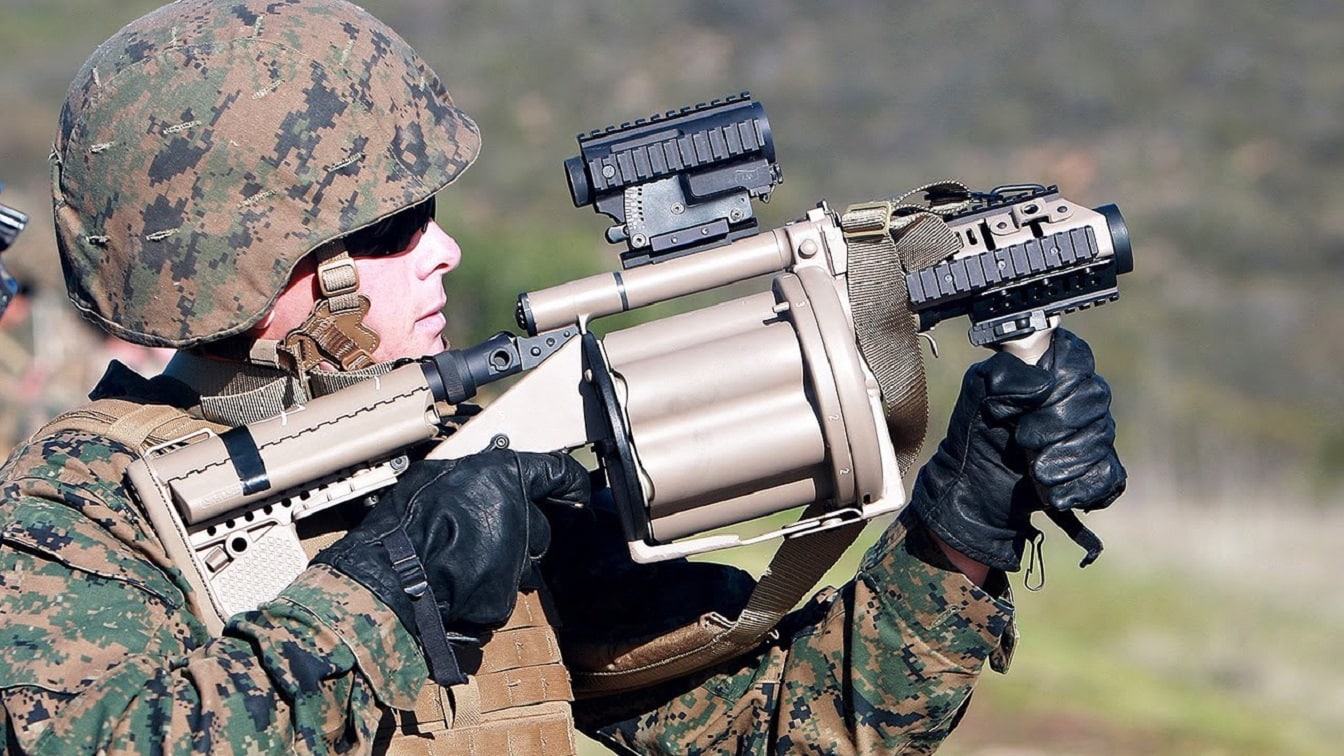M32A1: The US Marines Can Do Some Damage With Their Revolving Grenade Launcher – You know how a revolver works when it comes to shooting pistols. How about taking that same concept to create a rotating grenade launcher?
That’s what the U.S. Marine Corps enjoys in its M32A1 Multi-shot Grenade Launcher. This thing brings the heat quickly. Marines can rapid-fire six 40mm grenades in less than three seconds.
The M32A1 is a thing of combat beauty and it’s powerful enough to destroy point targets or to keep the enemy’s head down while suppressing their fire. The M32A1 is like a hand-held mortar that is more accurate than when Marines throw the grenade themselves. Plus, it could someday even launch drones from its tubes.
The M32A1 Is Not Just for Marines
The South Africans helped develop the multi-shot grenade launcher in the 1980s. Marines first began testing the M32A1 in 2005 and ordered 9,000 units in 2006. This grenade launcher is popular. Dozens of countries use them. It’s like having a shotgun that can launch grenades quickly and accurately.
It Has Ample Range and the Results Are Deadly
The M32A1 can be loaded with low-velocity or medium-velocity grenades. Marines can select the type of grenade for launching without having to change out the load. When they are trying to suppress an area, the launcher can cover nearly 444 square yards. The maximum range for point targets is 437 yards with low-velocity grenades and 875 yards with medium velocity.
Rail System Is a Plus
The weapon is treated with a Teflon nickel coating that keeps the dust, grime, and corrosion down to a minimum. It has the familiar Picatinny rail system that allows for adding a full-range of different accessories from sights to laser aiming modules.
The multi-shot grenade launcher is 26 inches long and weighs 18.4 pounds when loaded. This heftiness means that a marine grenadier is not likely to carry an M4 carbine, unlike the rifle-mounted underslung M203 grenade launcher.
Better Than a Thrown Hand Grenade and Able to Serve as a Mini-Mortar
The upside is the weapon’s rate of fire and range. It sits in a sweet spot – in between a thrown hand grenade and a mortar round. It has served the marines well in urban combat in Iraq and village-fighting in Afghanistan. The M32A1 can engage the enemy hiding behind walls or in bunkers. The launcher can also fire at militants in open areas. So, you can see how valuable it is in a marine squad.
Could It Launch a Bevy of Mini-Drones?
Since the M32A1 has proved itself on the battlefield as a grenade launcher, how about expanding its capabilities with new use cases?
One concept would be for it to fire mini-drones in quick succession. No word on whether the Marines are actually testing the M32A1 as a drone launcher, but the idea is interesting.
New Drone40 Would Be an Intriguing Pairing
One drone that the M32A1 could be married with is the Marine Corps’ Drone40.
Meant to be sent downrange with a grenade launcher, the Drone40 is a force multiplier. Marines control it with a smartphone or tablet. It’s a mini-quad copter that has a 12-mile range and fly for up to an hour. It can be recovered and used again after launch.
Drone40 Has Multi-mission Versatility
There is a small camera on board for collecting intelligence during surveillance and reconnaissance mode. It can carry smoke to conceal marines’ movement. Marines can fasten a small explosive charge to it. The Drone40 can also be equipped with a laser designator to laze targets or even jam enemy communications with electronic warfare capabilities.
M32A1: The Bottomline
The M32A1 has many advantages. It fires quickly and precisely. It’s popular with numerous militaries that deploy it in the field. The M32A1 is man-portable and functions as a mini-mortar for point and area targets. The weapons could also launch a squadron of mini-drones to make marine infantry even more lethal with valuable situational awareness.
Now serving as 1945’s Defense and National Security Editor, Brent M. Eastwood, PhD, is the author of Humans, Machines, and Data: Future Trends in Warfare. He is an Emerging Threats expert and former U.S. Army Infantry officer. You can follow him on Twitter @BMEastwood.

